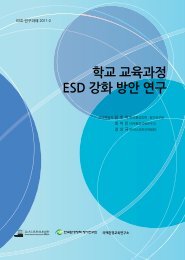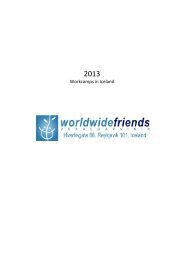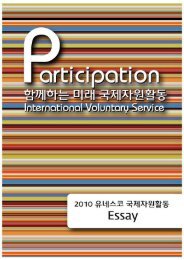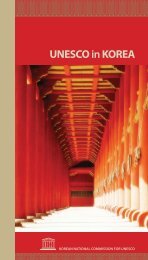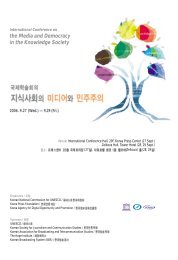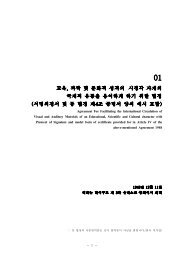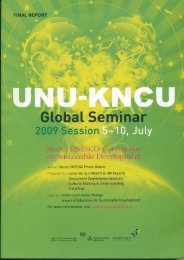íëìë³´ë2012문íì ë°ì ë¼ì´ëí ì´ë¸.pdf - ì ë¤ì¤ì½íêµììí
íëìë³´ë2012문íì ë°ì ë¼ì´ëí ì´ë¸.pdf - ì ë¤ì¤ì½íêµììí
íëìë³´ë2012문íì ë°ì ë¼ì´ëí ì´ë¸.pdf - ì ë¤ì¤ì½íêµììí
Create successful ePaper yourself
Turn your PDF publications into a flip-book with our unique Google optimized e-Paper software.
advanced architecture, crafts, music, and dance. The craftsmanship of these people is mostly<br />
developed at the family level. Master jewelry craftsmen, stone craftsmen, and carpenters<br />
form communities. Master craftsmen train village children, and knowledge is passed through<br />
generations as tradition. Dakson and McGregor (2012)'s in-depth interviews in the region<br />
clearly show that development achieved through tradition helps maintain cultural diversity<br />
and promotes the development of communities.<br />
Although the immediate economic effects from the craft production and cultural activities<br />
are not substantial, the benefits are big in light of life autonomy, well-being, and the<br />
livelihood sustainability of community members. Behind the success of Kandi's livelihood<br />
model lies three major factors: First, craftsmen inherit the tradition of their people and further<br />
develop skills within their culture. To the indigenous people, it is important to achieve selfdevelopment<br />
by increasing their cultural autonomy and competence while conserving their<br />
tradition. Crafts in Kandi exist in arts and culture that originate in tradition. Crafts can be<br />
considered to be a genre of art represented by culture as a tool - i.e. material culture - rather<br />
than culture as a simple value. They constitute an important part representing material culture.<br />
Second, in the Kandi model, all family members play a big role in overcoming poverty by<br />
making the most of their abilities. Especially in developing countries, women are known to<br />
play the most significant role in household income. To earn more income, both men and<br />
women must participate as the labor force. Generally, women have no choice but to work as<br />
street vendors or other such simple manual work that does not require special skills. In<br />
contrast, women in Kandi have learned and mastered traditional skills for generations, thus<br />
playing an important role in the economy. They are not just housewives; they build<br />
confidence in their abilities by producing results as crafts experts.<br />
Finally, residents of Kandi showed a high level of satisfaction in doing traditional work,<br />
which led to a stronger identity of community and increased solidarity. The case of Kandi is<br />
keeping with the concept of social capital in that social and economic development can be<br />
easily achieved in societies where reciprocity is valued due to the existence of social<br />
networks and strong solidarity (Putnam, 1995).<br />
Thus, a sustainable livelihood model for overcoming poverty, as made evident in Kandi's<br />
case, is centered on sustained education aimed at providing jobs and fostering future<br />
craftsmen in the crafts industry, with the major components of this model being craftsmen,<br />
women, and the local community. Jobs have been created, educational systems continued<br />
through craftsmen who are autonomous and competent in their work, women have become



